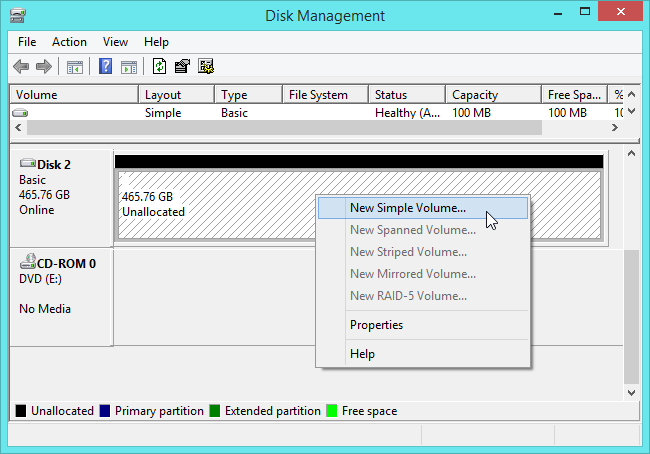

- #Which file system for windows and mac how to
- #Which file system for windows and mac mac os
- #Which file system for windows and mac mac
The following steps show you how to format your primary drive when all applications and your files are gone. Then you can use the Windows setup program or macOS Recovery Environment to format primary hard drives. You may need to reinstall the operating system, but you don‘t want to lose your data! If it’s at all possible, begin by backing up and rescuing everything of importance, or clone your hard drive by using one of our guides: How to clone a hard drive.
#Which file system for windows and mac mac
Follow the on-screen instructions when the New Simple Volume Wizard appears.How to Format a Hard Drive on Windows or Mac | Avast Logo Ameba Icon Security Icon Security White Icon Privacy Icon Performance Icon Privacy Icon Security Icon Performance Icons/45/01 Security/Other-Threats Icons / 32 / Bloatware removal Icons / 32 / Registry Cleaner Icons / 32 / CleanUp Icons / Feature / 32 / Mac Icons / 32 / Browser cleanup Icons/32/01 Security/Malware Icons/32/01 Security/Viruses Icons/32/01 Security/Other-Threats Icons/32/01 Security/Passwords Icons/32/01 Security/Ransomware Icons/32/01 Security/Business Icons/32/02 Privacy/Browser Icons/32/02 Privacy/IP adress Icons/32/02 Privacy/VPN Icons/32/02 Privacy/Proxy Icons/32/02 Privacy/Streaming Icons/32/03 Performance/Celaning Icons/32/03 Performance/Drivers Icons/32/03 Performance/Gaming Icons/32/03 Performance/Hardware Icons/32/03 Performance/Speed Icons / 32 / Bloatware removal Icons / 32 / Registry Cleaner Win Icons / 32 / CleanUp Icons / Feature / 32 / Mac Icons / 32 / Browser cleanup Icons/60/02 Privacy/02_Privacy Icons/60/01 Security/01_Security Icons/60/03 Performance/03_Performance Icons/80/01 Security/IoT Icons/80/01 Security/Malware Icons/80/01 Security/Passwords Icons/80/01 Security/Ransomware Icons/80/01 Security/Viruses Icons/80/01 Security/Other-Threats Icons/80/03 Security/Business Icons/80/02 Privacy/Browser Icons/80/02 Privacy/IP adress Icons/80/02 Privacy/VPN Icons/80/02 Privacy/Proxy Icons/80/02 Privacy/Streaming Icons/80/03 Performance/Celaning Icons/80/03 Performance/Drivers Icons/80/03 Performance/Gaming Icons/80/03 Performance/Hardware Icons/80/03 Performance/Speed Icons/80/03 Performance/03_Performance Icons/80/02 Privacy/02_Privacy To create a new partition, right click on the volume and select New Simple Volume.If it is currently formatted, right click on the partition and then choose Delete. The partition must be available to format.From the list of storage devices in the middle of the Disk Management window, locate your Seagate device.In the search results, double-click Disk Management. Go to Search and then type diskmgmt.msc.Make sure the storage device is connected to and mounted on the computer.For Format, select OS X Extended (Journaled).This will be the name displayed when the drive mounts. This feature was introduced in macOS 10.13 and is not available in 10.11 or 10.12. The view button is in the upper left side of the Disk Utility window. If you don’t see two entries listed in the sidebar, change the view in disk utility to show both the drive and the volume.

MacOS starting version 10.13-Make sure to select the disk and not just the volume. A FAT32 partition can reach up to 32GB when formatted on a Windows PC. However, FAT32 is a legacy file system designed for low capacity hard drives and it is not recommended for modern hard drives or operating systems.

exFAT is not a journaled file system which means it can be more susceptible to data corruption when errors occur or the drive is not disconnected properly from the computer.įAT32-Compatible with macOS and Windows. APFS is only supported on macOS 10.13 or later.ĮxFAT-Compatible with macOS and Windows.Format Seagate Expansion SSD to HFS+ if you intend to use it with Time Machine. You cannot use an APFS-formatted disk as your Time Machine backup drive.Windows cannot natively read or write to HFS+ (journaled) volumes.ĪPFS (Apple File System)-An Apple file system optimized for solid state drives (SSDs) and flash-based storage systems. This file system remains the best option for external hard drives and is the only format compatible with Time Machine.
#Which file system for windows and mac mac os
Mac OS Extended (HFS+)-An Apple file system optimized for macOS 10.12 and earlier. macOS can read NTFS volumes but cannot natively write to them. If you use the drive with only one type of computer, you can optimize file copy performance by formatting the drive in the native file system for your operating system-NTFS for Windows or HFS+ for macOS. Seagate Expansion SSD is preformatted exFAT for compatibility with both Mac and Windows computers.


 0 kommentar(er)
0 kommentar(er)
